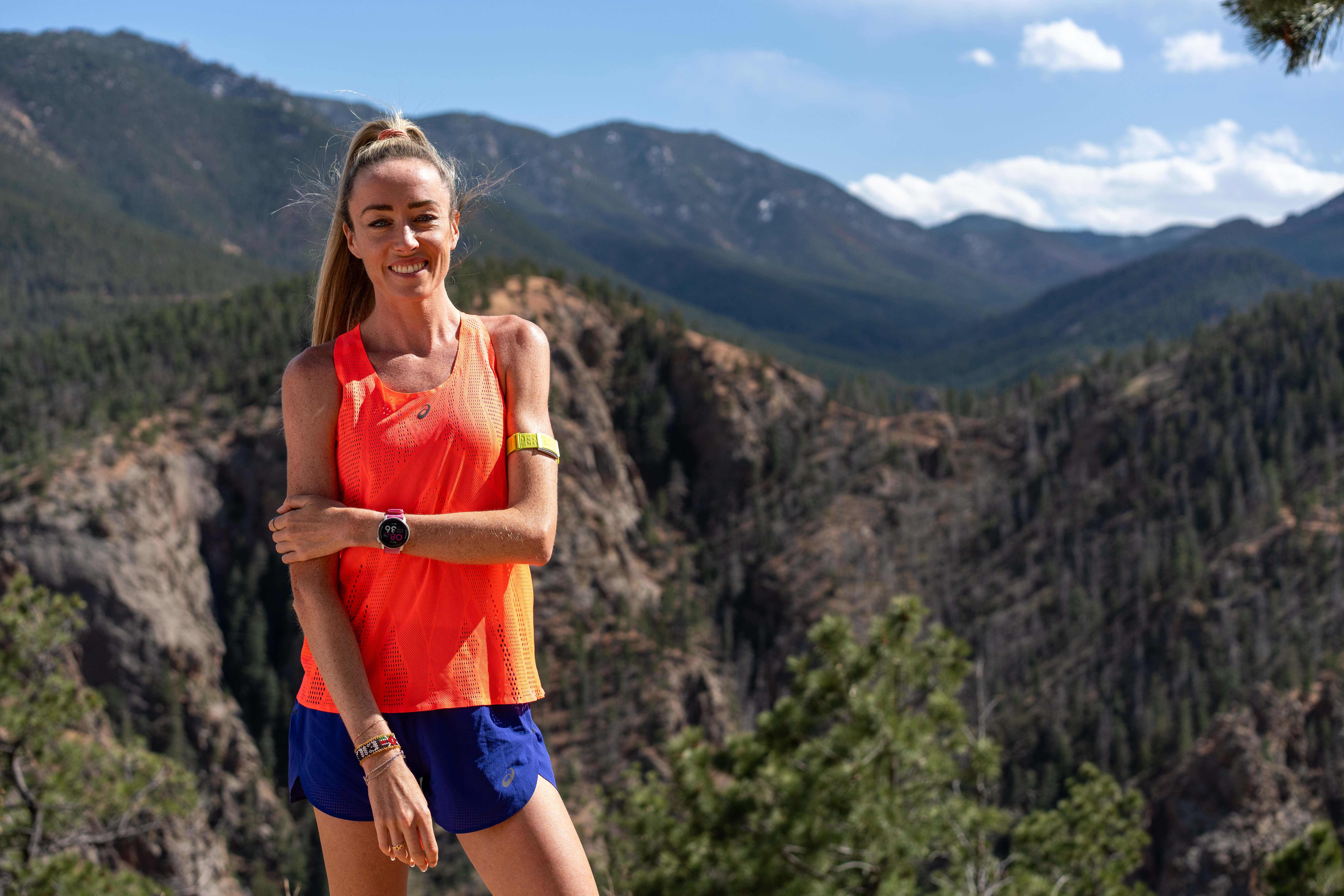
In early 2023, Eilish McColgan was London Marathon ready. The training was done, plans were in place, then a knee injury forced her to withdraw just days before the event.
“It was frustrating not to showcase the form I felt I was in, and get a race out of all the hard work I’d put into it,” the four-time Olympian and Coros athlete told me when we spoke. “So a marathon is certainly a goal for 2025. I haven’t confirmed which one just yet, but I’m certainly looking for a marathon performance next year.”
A couple of months later, McColgan’s spot was confirmed in the 2025 London Marathon elite women’s race – an event her mother won in 1996.
“I’m looking forward to the challenge of a marathon,” the 34-year-old says. “It’s frustrating to have done all the work and not have anything to show for it before. But it was a good experience, going through the whole build, because at least I know the type of training I need to do; what works and what maybe didn’t work. Hopefully in 2025 I’ll be able to turn it around a little bit.”
She plans to do this by combining hard work, tech and the know-how only years spent competing at the top level can bring. Below, we dive into her typical training week, refreshing approach to nutrition and surprising secret weapon for running faster, not further, than rivals each week.
Training for a long-distance race
When I spoke to McColgan, she was gearing up for the Vitality London 10,000 – a race she would go on to win in a time of 31min 36sec.
“Obviously mileage varies throughout the year, so it’s usually a bit higher in the winter months then even higher coming into races,” McColgan explains. “It cuts down by about half when I’m going into a big competition. That’s the general gist of training.
“Most days I will run in the morning, probably for about an hour, then go on a cross trainer or a spin bike in the evening” she adds. “Very rarely would I run twice a day, which is very rare for an elite athlete. But I’ve been coming back from a knee surgery at the end of last year, so I’m being really careful with how I build up my training and the volume I’m doing.”
Two of her weekly runs are “hard days” – interval sessions on the track, such as ten rounds of 1km efforts or 20 lots of 400m. She also tries to factor in one longer run per week. This might be 10 to 12 miles when preparing for a 10,000m race, or up to 20 miles as she aims to get marathon ready.
“The faster you can run in training, the easier it will feel in a race,” she says of intervals. “By splitting it up, you’re almost forcing the body into faster paces, so when you come back down to 10k pace it should feel a little bit easier.
“That’s also why a lot of runners will do a long run every week. You’re going further than your race distance would be, but at a much slower pace, so you’re almost coming at it from both sides – targeting the endurance side with the long run, then the speed side with the intervals.”
McColgan also does gym work twice a week, with a focus on building strength to prevent injuries. This, she says, was key when rebuilding muscle after her knee surgery in 2023.
“There are a lot of glute exercises like bridges and clams, then core stability exercises as well, just to keep everything strong and avoid potential injury further down the line.”
Read more: I tried the 12-minute workout Helen Mirren's used for her ‘whole life’
Nutrition for longevity
McColgan has never followed a strict diet plan. In her own words: “With the amount of training I’m doing, I just need to be getting fuel in and not worrying about it too much.”
“Training is so intense and life is so unusual as an athlete that I didn’t ever want food to become this really strict thing where I can’t feel like I’m having a normal life, if that makes sense?,” she says. “I want to be able to have a takeaway or go to a restaurant with my family without worrying about not being able to eat something because I have to follow a strict diet. I will eat whatever I want to eat.”
That’s not to say McColgan doesn’t pay attention to what’s on her plate. The majority of her meals are cooked from scratch, and she eats plenty of fresh fruit and vegetables throughout the day. But there’s always wiggle room, and this has helped her maintain a good relationship with food – something that’s not always the case with elite athletes.
“Athletes are quite obsessive by nature anyway; we’re training hard to win, we love what we do, we do it every day,” says McColgan. “But I’ve seen other athletes become obsessive over food, and it’s gone south.”
“It’s really heartbreaking to see how some people are so controlled with it, particularly young female athletes. I do a lot of work with my not-for-profit Giving Back To Track promoting healthy relationships with food. Food is fuel. I think a lot of people overthink it. They worry that if they have one Mars bar, they’re going to run badly on the weekend, and I don’t ever want to send that message.”
McColgan tries to meet most of her nutritional needs with food, but takes some supplements such as protein shakes from sponsor Science In Sport to ensure she’s “covered all bases”.
Read more: A flexibility expert says these are the three best stretches for fighting tight hips
Eilish McColgan’s recovery tips

McColgan’s training is all about balance. Her two weekly interval sessions are incredibly demanding, so the remainder of her week has to be structured in a way that allows her to give her all on these days.
Her regular evening sessions on the cross trainer (her secret weapon) are regulated by heart rate, and she uses the Coros Pace 3 to ensure she stays in zone two (roughly 60-70 per cent of your maximum heart rate). This, she says, is a low-impact way of training her heart and lungs without hampering recovery.
“I always want to do more, go faster and push myself,” McColgan says. “Tracking my heart rate is a good way of saying, ‘Right, stay within these zones’. I’m not pushing myself so hard that it’s affecting my running sessions, because ultimately those running sessions are going to be what makes me a faster runner. Everything else on top of that is purely supplementary.”
She also uses her fitness tracker to monitor her heart rate variability – the fluctuation in the amount of time between your heartbeats, with higher figures often associated with increased “behavioural flexibility”, or “readiness for exercise”.
“The Coros Pace 3 shows this weekly map so you can see the changes day to day,” McColgan says. “It can even be an indication that you’re coming down sick, which has been really interesting for me. It’s been spot on when it’s been a bit low. I’ve gone to train and thought, ‘I don’t feel right here’, and the next day I’ve not been well.”
She always double-checks this data against how she feels, then uses this two-pronged feedback to inform her training.
“If the way I feel is matched by the stats on my watch, I know that’s probably an indicator to take an extra rest day or switch my days around,” says McColgan. “I’m a full-time athlete, and there are 24 hours in a day, seven days in a week – I don’t have to do a session on a Tuesday night at 6pm because the club’s there or because my coach is there. I can be flexible.”
“Even things like being a female, hormones, time of the month, all those things can factor in and be an added stress on the body. It’s really important that I do have a flexible programme and I don’t just try to religiously stick to it as I did as a kid. I think that comes with experience.”
Beyond this, McColgan also takes one full recovery day per week, aims to hit at least eight hours of sleep per night, and uses recovery tools to keep her body feeling good.
“Trying to get eight hours a night is pretty crucial,” she says. “I notice a big difference, even in the recovery stats on my watch, if I have one or two bad night’s sleep, especially when I'm training hard. It’s hard to try and catch that back up again.
“Then even small things like recovery, stretching, foam rolling; all of those things are really important just to try and keep your body loose and the muscles relaxed when you’re in heavy training.”
Read more: Here’s how to start running if you’re a beginner
What’s next for Eilish McColgan?
McColgan raced in the 10,000m at the Paris 2024 Olympic Games, becoming the first athlete from Scotland to make four appearances at the competition. After battling injury to make it to the start line, she finished 15th – a result she described as “disappointing” in an interview with BBC Radio Scotland.
"I'd have liked to have finished my track career on a really positive moment, but you can't expect miracles when you've only had five weeks training behind you,” she explained.
McColgan already has a fifth Olympics in her sights, but says competing on the track at the LA 2028 Olympics is “off the agenda”. If she does compete, “it would realistically be a marathon”.
But for now, all eyes turn to London, with McColgan set to make her competitive marathon debut at the event in late April.
Read more: This is how much protein you need each day, according to a nutritionist







